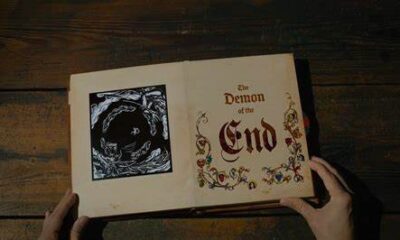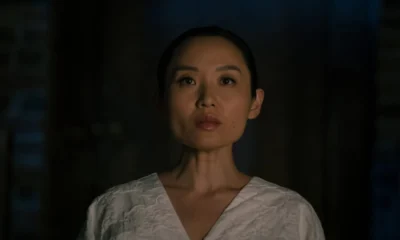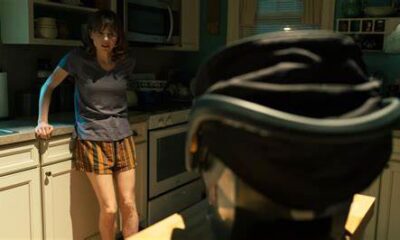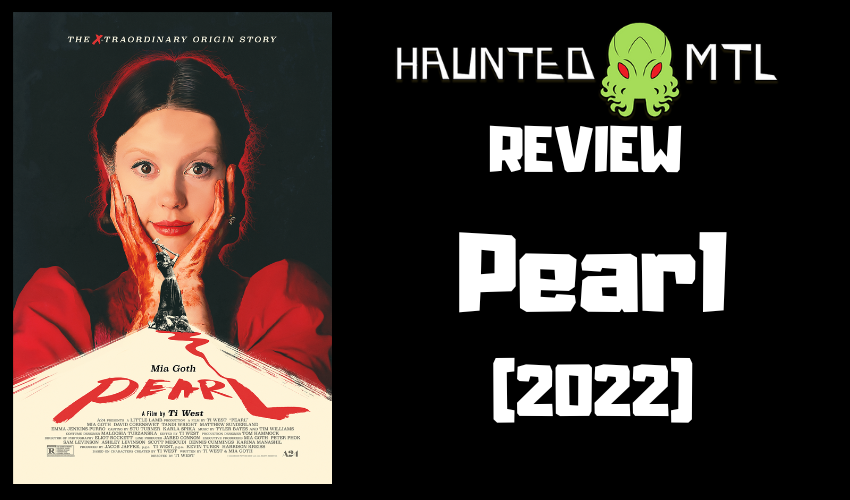
‘Pearl’ (2022) Review
With Pearl, director and writer Ti West managed to create a duology of horror films loved by critics and audiences. However, does this second film in a soon-to-be trilogy stand on its own? Or do the expectations of being a prequel derail it? Does Pearl prove a worthy successor to X?
As someone who is a fan of Ti West, I can answer that simply; Horror fans feast this year. Pearl is a movie that will stick with you long after the upsetting credits sequence.

Pearl (2022)
Director and writer Ti West (House of the Devil) strikes horror gold twice in one year in his X follow-up, Pearl. Pearl is a gothic slasher film that serves as a prequel to X. The movie explores the life of a younger Pearl, X‘s murderous biddy, against the 1918 outbreak of Spanish Influenza and the first World War. Pearl struggles with her desire to leave the family farm and be a star. She is under the thumb of her domineering german mother, infirm father, and has a husband who is off fighting in Europe. However, Pearl’s life may take a turn through a meeting with a film projectionist and news of an audition for dancers.
The film stars Mia Goth (Suspiria), who co-wrote the film’s concept with Ti West during the production of X as the coronavirus outbreaks was in full swing, as she reprises the role of Pearl from X with significantly less make-up. The film also stars David Corenswet, Tandi Wright, Matthew Sunderland, Emma Jenkins-Purro, and Allistair Sewell.
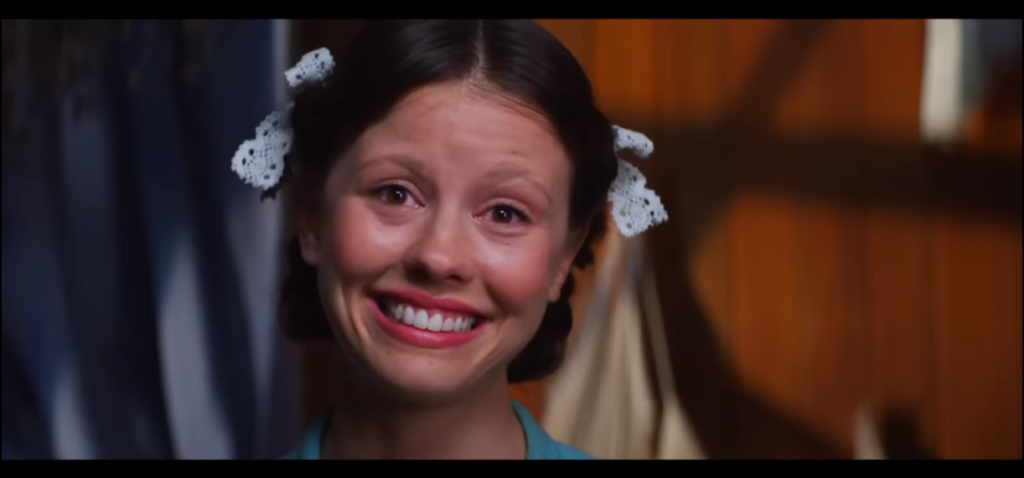
What worked with Pearl?
There is a lot to love about Pearl, and in many ways, the prequel is more surprisingly ambitious than X. Pearl, at its best, functions as a companion to X, not necessarily as a prequel that establishes story elements, but rather in themes. That is not to say the film is overly beholden to what came before it, either. The film cleverly evokes the pandemic-era anxiety with the historical Spanish Flu and weaves a pandemic into the story that feels modern but does not overwhelm the rest of the film. The film rhymes with its predecessor in several ways, such as attitudes toward sexuality and pornography, ambition and violent escapism, and even down instances of dialogue. Like Ti West’s earlier collaboration with Mia Goth this year, the film has that x-factor.
“The X-Factor”
Speaking of Mia Goth. Goth is delightful in X as an elderly Pearl and Maxine Minx. However, the way she is unleashed as the young Pearl in this movie is one of the most impressive performances I have seen in a film this year and maybe in the past few years. She is frightening, ambitious, beautiful, terrifying, tragic, charming throughout, and utterly carrying the film. That is not to say that the other performers do not pull their weight, but compared to the role of Pearl, there isn’t as much to do, and they’re better off standing out of the crossfire as Mia Goth decimates the audience. A five to six-minute monologue in the film’s climax featuring Pearl laying bare her sickness and sadness floored my wife and me.
Pearl is also a visually stunning film, down to the technicolor-era trappings of title cards and supernaturally bright colors. Ti West knows his way around a camera, and Eliot Rockett’s cinematography provides a beautiful combination of old-Hollywood visual language with some of Ti West’s usual bag of tricks and some of his go-to editing techniques. Zooms, in particular, carry a terrifying power in this film.
The sumptuousness of the color also works well with the film’s period details, such as costuming and the music by Tyler Bates and Tim Williams. Horror films can sometimes appear overly dark or dingy, but Pearl avoids this by embracing a look of old Hollywood just as X embraced a grind-house grit.
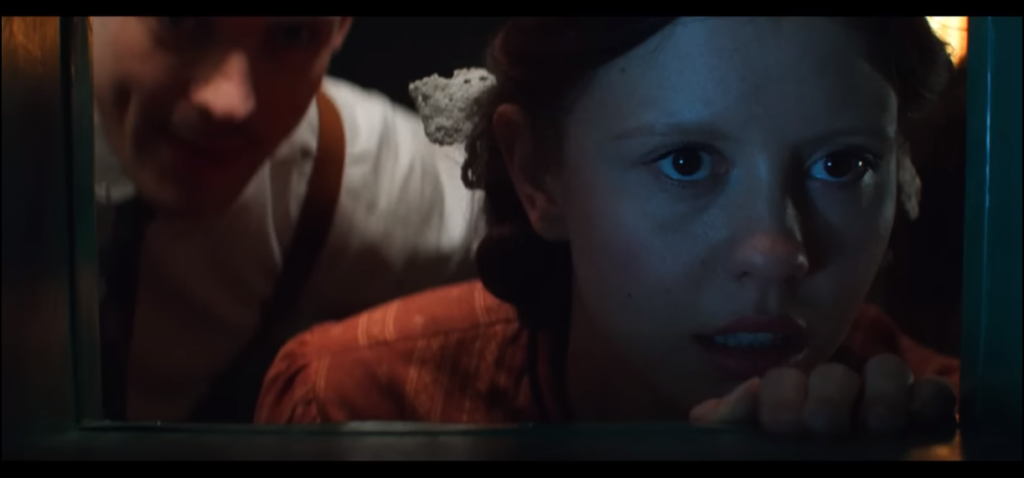
What didn’t work with Pearl?
As much as I loved Pearl, two things temper my appreciation. I think the film filling the role of a prequel to X does it a slight disservice and results in some minor problems. As a prequel to X, the film must line up Pearl’s story with the Pearl of the 1970s. It can be rough stitching at times. For the most part, the film is a success and rhymes with its technical sequel, but other times the threads and loose and frayed. Namely the role of Howard (Alistair Sewell) in the events that are to come in Pearl’s future.
Also, because there was an alligator in X, there must be one in Pearl. These kinds of checklist moments are acceptable, but something I feel also limited the film a bit compared to X. X succeeded in surprising me in some ways that Pearl simply could not because it is a prequel.
Secondly, my other criticism of the film is that Mia Goth’s Pearl so thoroughly devours it that it misses opportunities to explore the surrounding characters. In many ways, the movie sacrifices the extended cast on the altar of Pearl at the expense of a richer characterization. My complaints most derive from two characters: The Projectionist (David Corenswet) and Ruth (Tandi Wright), in that we get some tantalizing glimpses into deeper, richer characters. Frustratingly, these developments are cut short, so the characters suffer for it. Particularly the stern Ruth, whose story seems to run as deep and intertwined with Pearl’s, we do not get to explore. It is less so for The Projectionist, but his scenes reveal an interesting thematic connection to X. I would have loved to see that expanded.

Final Verdict on Pearl (2022)
2022 is an excellent year for horror fans as Ti West has delivered two of the most substantial horror projects of the year in X and Pearl. Ti West’s latest film is wholly subsumed by the charisma and presence of Mia Goth. While some of the necessary but perfunctory prequel elements are admirably handled, the strain of working within the confines of future events can take its toll on the film.
 (4 / 5)
(4 / 5)
Pearl is distributed by A24 and produced by Mad Solar Productions, Little Lamb, and Bron Studios. The film’s runtime is 102 minutes and can currently be seen in movie theaters.
We would love to hear your thoughts on the movie in the comments if you’ve seen Pearl. Enjoy the review? Check out our other horror reviews here on Haunted MTL.
Want more Pearl? (Sponsored)
Have you seen X (2022)? If not, consider picking up a blu-ray before you see Pearl in theaters. Use our special Amazon link to add to your movie collection and help support Haunted MTL.
Movies n TV
Wheel of Time A Question of Crimson Is a Political Espionage Delight
Episode two of Wheel of Time felt like the beginning of a long journey. Stories are unfolding, lives are changing, and blood is spilling.
Let’s discuss.
The story
We begin this episode in the past with Elayne’s mother, Queen Morgase. It turns out her rise to the throne was a bit, shall we say, cutthroat. So when she shows up at the White Tower, Siuan is concerned.
She might have reason to be, too.
Meanwhile, Rand, Egwene, Moiraine, Lan and Aviendha are in the Spine of The World. As they travel through some of the most breathtaking lands I have ever seen on a TV show, Egwene is plagued with nightmares. We think at first that’s just her trauma working itself through her system. But we soon find out that it might not be that straightforward.
Finally, Perrin returns home to heal after his hand is almost cut in half. But when he gets there he finds the town has been infested by Children of The Light. And they’re looking for him.
What worked
There was something heartwarming in this episode about political espionage and choking religious persecution. And that is Elayne’s relationship with her family.
I have consumed a lot of fantasy content with royal families. And I have never once heard a princess call her mother ‘Mum’. I’ve never seen royal siblings get along. And I have sure as hell never seen a princess have a good relationship with her step-parent.
This was refreshing. Even though Queen Morgase is kind of a horrible person she seems like a good mother. And that’s an unexpected delight.

Of course, this is just one storyline among many. And while this can sometimes be overwhelming, in this case it wasn’t.
I’ll be honest, some of these storylines are going to drag for me. I know this because I’ve read some of the Wheel of Time books and I have an idea that not all the characters exactly pique my interest.
No one likes all the characters. No one likes all the storylines. While I am here for the political espionage between Queen Morgase and Siuan, not everyone likes it. While others might be fascinated with Selene trying to win Rand back, I couldn’t care less.
Having multiple storylines keeps everyone’s attention better. So long as things don’t get out of hand. Things can easily get out of hand. But this seems to be managed well.
So far.
What didn’t work
As I mentioned above, I’m not thrilled with Rand’s story at this point. And while it’s fine to not like a storyline when there are this many to choose from, it’s not fantastic that the one I like the least is the one involving our two main characters. And anytime we were with the team at the Spine of The World, the only thing that brought me joy was Moirain’s hat. It reminded me of Stockard Channing’s hat in Practical Magic.
The problem is that Rand is Charlie Brown with controversial magical powers. He is boring, serious, and pessimistic.
And yes, I understand that he has a heavy emotional burden and he’s the Dragon Reborn and that’s quite taxing and all. But let’s be fair, there isn’t a single person in this show that doesn’t have a heavy burden. And most of them manage to be fun occasionally.

All that being said, this episode of Wheel of Time did exactly what it needed to do. It set up conflicts at each of the three locations. It established emotional ties between the characters and the events. And it established goals for everyone.
This was, in short, a solid episode. Not groundbreaking, not mind-blowing or life changing. It was simply good. It was entertaining and moved the plot forward.
Well done.
 (3.5 / 5)
(3.5 / 5)
Movies n TV
Wheel of Time Returns With A Bang
Wheel of Time is back for season three. There are mixed feelings regarding this. Last season, there were some serious pacing issues. And some serious sticking to the book’s storyline issues. But we’re two seasons in, and we don’t give up so easily. So let’s dive into episode one, To Race the Shadow.
By the way, I highly recommend watching this episode with the subtitles on. You’ll see why.
The story
We begin this episode with Liandrin facing a trial of sorts for her rampant betrayal. She does her best to gaslight her Aes Sedai sisters into thinking that Siuan Sanche is the real traitor.

When that doesn’t work, she reveals how many Black Aes Sedai have actually infiltrated the tower.
Spoiler, it’s a lot.
In the aftermath, our whole team gathers to drink and enjoy one night of relaxation before they head out to the Tear to form an army for Rand. All is going well until they’re attacked by myriad creatures and a sentient axe.
What worked
This episode was long. It had a run time of an hour and eleven minutes. And a lot of that run time was spent in heavy dialog scenes.
Fortunately, these were well-done scenes.
If you’re going to have a lot of talking scenes, there are good ways and bad ways to do it. Last season, we saw lots of examples of the bad way to do it. But this episode did it well. For one thing, other things were going on while conversations were taking place. The characters are drinking, playing games, walking through an interesting city. And the scenes themselves didn’t stretch out. They weren’t repetitive. We heard what the character had to say, then we moved on.
It was also nice that the point of these scenes wasn’t just info dumps. We had character development. We had romantic interactions. We had plot development and foreshadowing.
Overall, this episode felt like what it was. A moment of calm before a storm.
Taking a step back, I’d be remiss if I didn’t address the fight scene at the start of the episode. Because it was epic.
The magic looked amazing. The martial arts that went along with it looked fantastic. The costumes were beautiful. It was just incredibly fun to watch.
More than that, it was emotional. We lost some characters in that fight that were important. And it was clearly emotionally shattering for many of our characters, who found themselves betrayed by people they trusted.
So many of them.
It was a great way to open the season.
What didn’t work
Despite that, this episode wasn’t without its flaws.
First off, there were a lot of dialog scenes. And they were good scenes, as I’ve already discussed. But it was one after another after another. And when your episode is, again, an hour and eleven minutes, it’s maybe a little much to have so much chit-chat. Couldn’t some of these conversations, important as they were, have been moved to maybe another episode?
Finally, I want to talk about Egwene’s travel through the arches.

I feel like maybe there were some deleted scenes here. Because there must have been more to that visit than what we saw, right?
We could have seen Egwene battle Rand. That would have been badass and emotionally devastating. We could have seen her with a quiet life with Rand back home at the Two Rivers. We could have seen anything except for the quick clip of Rand in a bloody river, followed by Egwene being shoved back out in a bloody shift.
No products found.
Bad job. But at least it wasn’t an extended scene of Moiraine collecting bathwater, and then taking a bath while looking sad. If we’d started this season with another scene like that, it might have broken my brain.
Amazon dropped the first three episodes at once. So we’ll be back soon to talk about episode two. See you then.
 (4 / 5)
(4 / 5)
Movies n TV
Entertaining as hell: Eight Legged Freaks (2002) Review
Early 2000s is a special era for the industry. It accepts the cheesiness and corniness of movie making, in turn producing some gems in their own right. Eight Legged Freaks starring David Arquette and young Scarlet Johanson is a horror comedy about giant spiders who overtake a small town. As crazy as that premise sounds, the movie surprisingly has a ton of heart and is super entertaining. Let’s review, shall we?
Plot
We start Eight Legged Freaks with a shot of toxic waste spilling into the water supply of Joshua, a spider farm owner. He is friends with Mike, one of our protagonists, who is a science geek and a spider enthusiast. Mike notices something quite right upon visiting Joshua, but no one takes him seriously. We are then introduced to the rest of the crew. Mike’s mother Samantha, the town sheriff, is too busy chasing Ashley, his sister, who is dating the town mayor’s son Bret (something Samantha does not approve of). We also have Chris, who returns to the town to save his father’s legacy in the town mines. He has opposition from Wade, Bret’s father, who wants to use the mines for his business ventures. Lots of drama going on that will only get juicier once the spiders get loose.
The creepy crawlies quickly dispose of Joshua and make their grand appearance after Ashley rejects Bret’s advances, abandoning him in the middle of a desert. A glorious chase sequence ensues as the spiders make their way towards the town, wreaking havoc on its residents. In a true horror fashion (which the movie acknowledges), it takes some convincing from Mike and then from Samantha for the town to take the threat seriously. The tongue-in-cheek style of narrative adds the comedy aspect to a movie that would otherwise burn out fairly quickly.
The remaining characters hide out in a shopping mall as it’s the only somewhat sturdy building in the area. This doesn’t last long as the spiders break in, forcing them to run through the mines. Their resources to fight the creepy crawlies off are limited as the methane gas doesn’t allow them to use firearms. Such conditions require resourceful thinking from Chris, who uses perfume to fend off the leader of the spider group and save himself during the climax of the movie.
Character dynamics are not forgotten once the action kicks in. We have Chris confessing his long-term feelings for Samantha which she knew all along, which provided some comedic relief. Bret also reunites with Ashley and apologises for being an asshole. Mike finally gets the appreciation he deserves as his knowledge saves the townsfolk more than once during the whole ordeal.
We end the movie with the town’s radio show person telling the story as an urban legend during his segment. This brings it into question – how much of it happened the way he said it did? We can only guess…
Overall thoughts
Eight Legged Freaks is a fun creature feature with some self-aware commentary on genre tropes that doesn’t take itself too seriously. The acting is good, the pacing fitting and the characters are likeable enough for you to want them to make it through. Definitely a must watch, if you don’t suffer from arachnophobia, that is.
 (5 / 5)
(5 / 5)
- What do you get when you cross toxic waste with a bunch of exotic spiders? Eaten! The townies of Prosperity, Arizona will all become a screaming smorgasbord if mutated arachnids as big as SUVs have their way in this comedy/horror crowd pleaser whose creators include the producers of Independence Day and Godzilla
- Spiders that leap like gazelles, web-spitting spiders, spiders that suck your insides out as if through a straw—they’re all among the behemoths conjured up by an inventive effects team
- David Arquette (Scream) leads the two-legged stars, mobilizing the citizenry in a last-ditch fight to survive
Last update on 2025-03-10 / Affiliate links / Images from Amazon Product Advertising API




